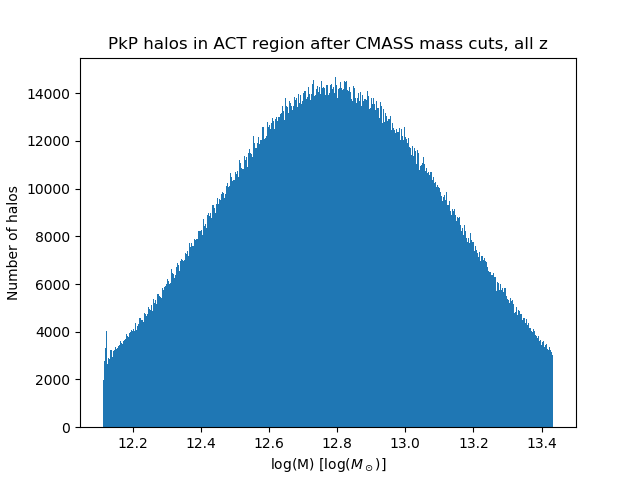Difference between revisions of "April 29, 2019"
| Line 6: | Line 6: | ||
1) Project all the halos onto a Healpix map. Keep only the ones that fall in the same sky regions I defined for the DES clusters and CMASS galaxies. I keep a larger rectangle of galaxies than of clusters because I don't want clusters on the edge to have strange orientation effects. | 1) Project all the halos onto a Healpix map. Keep only the ones that fall in the same sky regions I defined for the DES clusters and CMASS galaxies. I keep a larger rectangle of galaxies than of clusters because I don't want clusters on the edge to have strange orientation effects. | ||
| − | 2) From this reduced catalog take an approximately Gaussian distribution of masses centered on logM = 12.87 (where M is in M_sun) with a standard deviation of 0.37, which should match the CMASS sample. See | + | 2) From this reduced catalog take an approximately Gaussian distribution of masses centered on logM = 12.87 (where M is in M_sun) with a standard deviation of 0.37, which should match the CMASS sample. See figure below. |
| − | |||
| + | [[File:Pkpatch bossgals masscut.png]] | ||
3) Divide these halos into bins of 100 Mpc. For each bin, take a random sample of n halos, where n is the number of CMASS galaxies in that region of redshift space. | 3) Divide these halos into bins of 100 Mpc. For each bin, take a random sample of n halos, where n is the number of CMASS galaxies in that region of redshift space. | ||
| Line 14: | Line 14: | ||
4) For the clusters, take the sample left after step 1 and for every 100 Mpc bin, keep the top x halos. Here x is the number of DES Redmapper clusters in that region of redshift space. | 4) For the clusters, take the sample left after step 1 and for every 100 Mpc bin, keep the top x halos. Here x is the number of DES Redmapper clusters in that region of redshift space. | ||
| + | == Peak Patch stacks == | ||
| − | + | For now, I am | |
== Simulation stacks == | == Simulation stacks == | ||
[[File:Example.jpg]] | [[File:Example.jpg]] | ||
Revision as of 03:36, 30 April 2019
Peak Patch Halo Selection
These are the steps that I use to select halos from the full-sky high-redshift Peak Patch lightcone run.
1) Project all the halos onto a Healpix map. Keep only the ones that fall in the same sky regions I defined for the DES clusters and CMASS galaxies. I keep a larger rectangle of galaxies than of clusters because I don't want clusters on the edge to have strange orientation effects.
2) From this reduced catalog take an approximately Gaussian distribution of masses centered on logM = 12.87 (where M is in M_sun) with a standard deviation of 0.37, which should match the CMASS sample. See figure below.
3) Divide these halos into bins of 100 Mpc. For each bin, take a random sample of n halos, where n is the number of CMASS galaxies in that region of redshift space.
4) For the clusters, take the sample left after step 1 and for every 100 Mpc bin, keep the top x halos. Here x is the number of DES Redmapper clusters in that region of redshift space.
Peak Patch stacks
For now, I am
